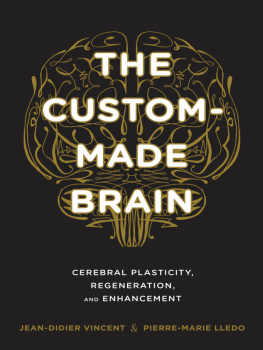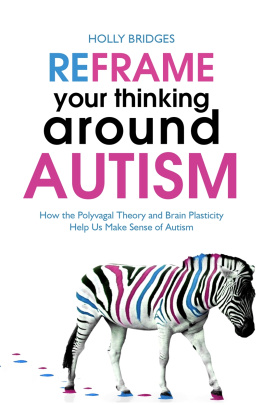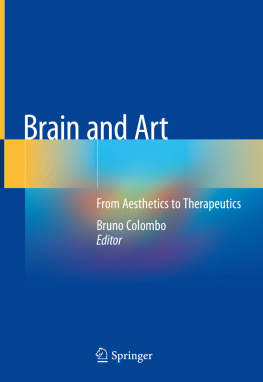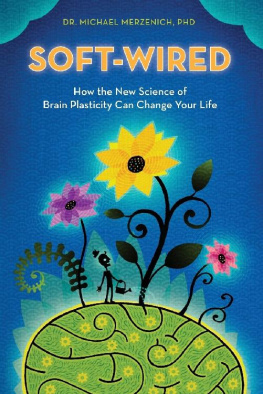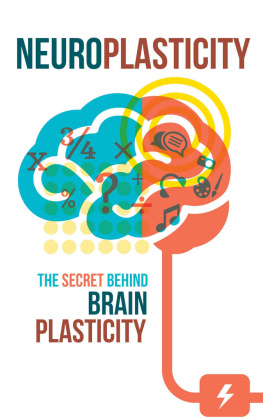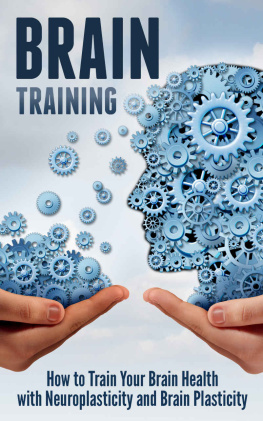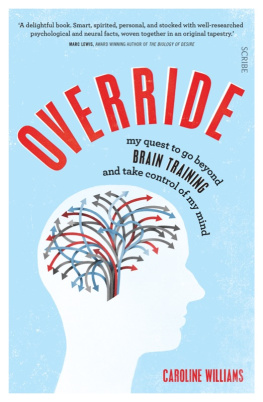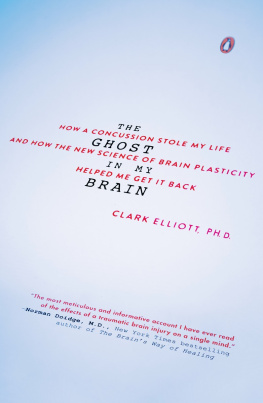THE CUSTOM-MADE BRAIN
THE
CUSTOM-MADE BRAIN
Cerebral Plasticity, Regeneration, and Enhancement
Jean-Didier Vincent and Pierre-Marie Lledo
Translated by Laurence Garey
COLUMBIA UNIVERSITY PRESS NEW YORK
Columbia University Press
Publishers Since 1893
New York Chichester, West Sussex
cup.columbia.edu
Originally published as Le cerveau sur measure, copyright 2012 Odile Jacob
This English-language edition copyright 2014 Columbia University Press
All rights reserved
E-ISBN 978-0-231-53421-5
Library of Congress Cataloging-in-Publication Data
Vincent, Jean-Didier, author.
[Cerveau sur mesure. English]
The custom-made brain : cerebral plasticity, regeneration, and enhancement / Jean-Didier Vincent and Pierre-Marie Lledo. English-language edition.
pages cm
Includes bibliographical references and index.
ISBN 978-0-231-16450-4 (cloth : alk. paper) ISBN 978-0-231-53421-5 (e-book)
1. BrainPhysiology. 2. Brain stimulation. 3. Neurophysiology. I. Lledo, Pierre-Marie, author. II. Title.
QP376.V52713 2014
612.8'2dc23
2013040696
A Columbia University Press E-book.
CUP would be pleased to hear about your reading experience with this e-book at .
COVER DESIGN AND ART: Alex Camlin
References to websites (URLs) were accurate at the time of writing. Neither the author nor Columbia University Press is responsible for URLs that may have expired or changed since the manuscript was prepared.
In memory of my father who inspired the title of this book.
To my dearest mother for her unfailing love. You alone incarnate all the injustice of a neurodegenerative disease become sadly too common.
P-ML
To my children and grandchildren, whose brains bear the hopes of my genome.
J-DV
CONTENTS
WE WISH TO THANK all those who, directly or indirectly, have contributed to making this book possible. Without rigid classification and in no particular order, we rely on our memory to recall them with our greatest affection.
First of all we thank all the members of the Perception and Memory Laboratory at the Institut Pasteur for their assistance and their readiness to share the joys of research.
We are grateful to Gilles Gheusi, Pierre-Jean Arduin, Dominique Martinez, and Serge Picaud for having agreed to read the manuscript in whole or in part. Their remarks, on form or fact, have certainly contributed to improving it significantly.
We express our gratitude to two colleagues, Henri Korn and Jean-Pierre Changeux, for their valuable and sustained exchanges, and their ever enlightened advice.
Finally our thanks would not be complete if I had not had the good fortune to have beside me Pascale, Isabel, and Clment, as well as Daniel, Jean-Bernard, Dominique, Grard, and Christian, with their generous support.
P-ML
Above all, thanks to Pierre-Marie Lledo and all his team at the Institut Pasteur for our mutual understanding.
To Philippe Vernier, my faithful friend, who welcomed me to his research team on Neurobiology and Development at the Alfred Fessard Institute of Neurobiology (INAF), where he so brilliantly succeeded me.
To Odile Jacob and Bernard Gotlieb for their constant support, and Jean-Luc Fidel, without whom this book would not exist.
To Hlne Hryn for her help in using an instrument that terrifies me, the computer.
To my friend Jean-Franois Moueix for his discreet presence at my side on the paths of the selva obscura.
To the wanderers in the hills, the Chief and the Colonel, without whom the Bordelais countryside would be less beautiful. To the Lysottes, lord and lady of the manor of Gourgue, for their amiable sovereignty.
Finally, to the Verdiers, Mamie, Alain, and Kk, and to Ren Biandon, my epigenetic family.
J-DV
WHEN BRIDGET FLANNERY-MCCOY asked me if I would be willing to translate Le cerveau sur mesure I was particularly happy to accept. I looked back with pleasure to the time in the late 1970s when Jean-Didier Vincent and I served on the Committee of Administration of the Institute of Neurophysiology and Psychophysiology in Marseille, directed by the late Jacques Paillard. I remember Jean-Didiers subtle rigor and his polite but cutting humor.
I have long admired his works, which deal with an aspect of neuroscience of which he has become a master, what I might call the affective brain. He writes less about the brains basic sensorimotor tasks and more about love, emotion, passion, and instincts, aspects that make the human brain different from that of other species. Jean-Didier Vincent and Pierre-Marie Lledo now offer us yet a different view of the custommade brain and discuss its long evolutionary history, over both the millennia and over the time of its development in the embryo. They explain the importance of our acquiring a head in which to keep this precious brain; they then take a somewhat novel look at nature and nurture. We follow the brain from the cutting room, where the tailor makes it to measure, through the repair workshop, but the authors go even further and make us wonder what the future might hold in terms of augmenting natures gift: brains enhanced by drugs and computers.
Translation is not just a matter of substituting words: it is an attempt to convey authors ideas in a new language, and there are pitfalls all along the way. I have modified some of the layout of the original while trying to retain the feel the authors gave to their work. If I have succeeded, then I am pleased: if I have failed it is my responsibility alone, and I beg the authors indulgence. I have enjoyed translating this fascinating book, and I hope the readers will enjoy it as much.
PERROY, JULY 2013
Man and his brain, no big deal!
ANONYMOUS
ONE OUGHT REALLY TO SAY, Man and his brain, what a marvel! A man does not realize his brain is there, just as he does not feel a well-fitting suit: he forgets about it. Our head may feel heavy or painful, but, paradoxically, the brain, our organ of sensation, is without feeling, a soft mass painless even to the surgeons scalpel. It is carved from the same pattern for an entire species, but it expresses each individuals self, in other words, his mind.
The history of the human brain is intimately related to the odyssey of our species, which appeared about 200,000 years ago with a modern brain that has not evolved since. Who are these people who appeared toward the end of the Quaternary? Whether male or female, they had naked skin but hair on their heads. He soon learned to hide his penis and protect it from thorns along his path. She exhibited her pendulous breasts and fat buttocks as marks of her femininity. They showed neither shame nor modesty; clothing came later, together with morality and law. They experienced emotions but above all felt compassion, a characteristic born of natural selection and fundamental to the development of their species. These creatures with short canines and no claws could never have survived without mutual aid and the capacity to read one anothers minds, to guess their intentions and feelings. They walked in step, and their thoughts passed freely from one brain to another. Their eyes lit up by day and chased solitude away. At night they slept under the stars as if they rose from the flames of their fires.
What every gardener knows is true for all men: they are a product of the earth. So it is natural that their fate be linked to that of the soil that bore them. Six or seven million years ago, East Africa underwent a drought that led to the disappearance of the tropical forest and its replacement by woodland savanna. Moving from branch to branch was difficult, and this favored the appearance of bipedalism among the great apes that began to move at ground level. They were the forebears of humanity with a brain of only 400 grams (just under a pound). The famous Lucy was the jewel of the genus

